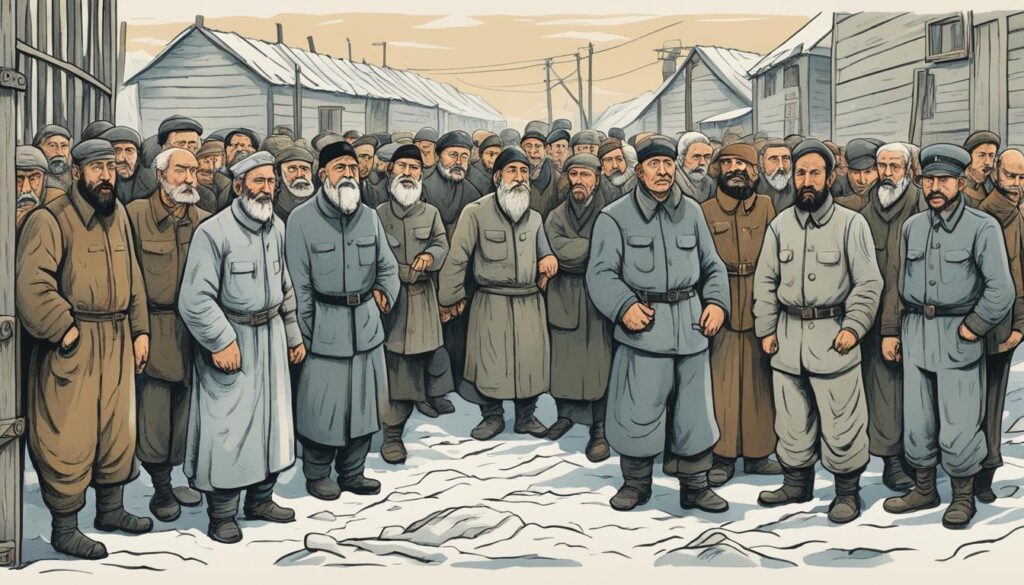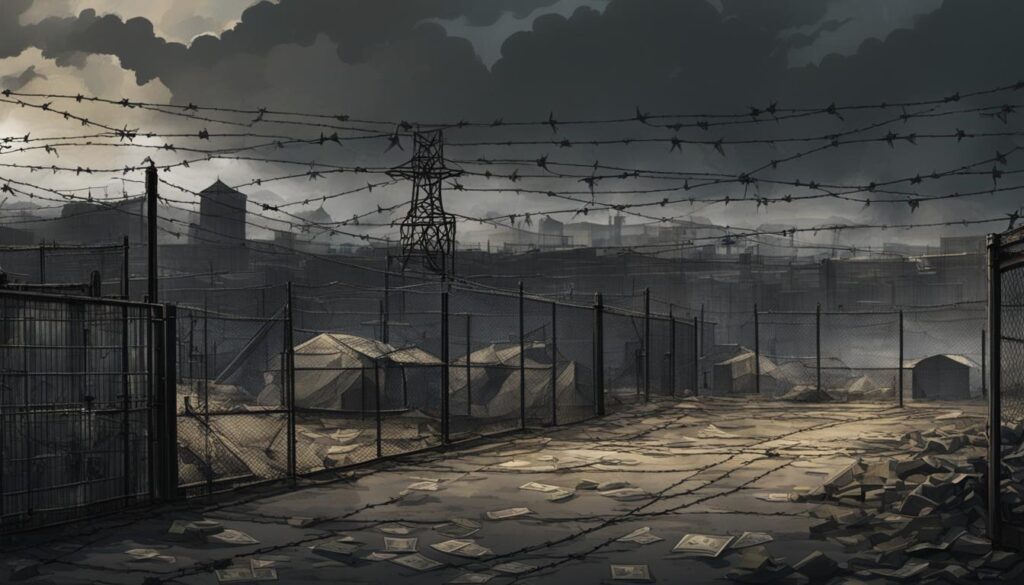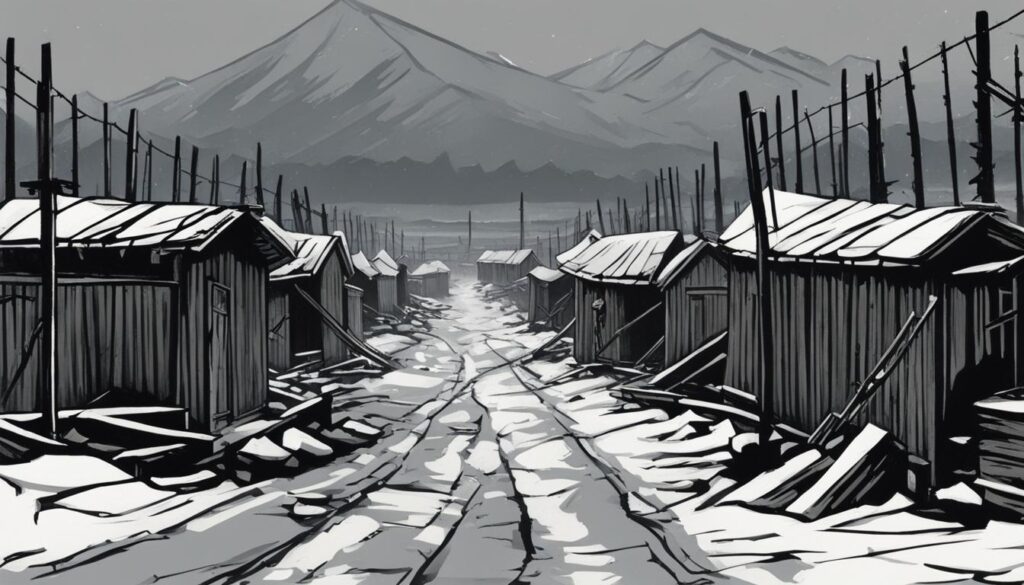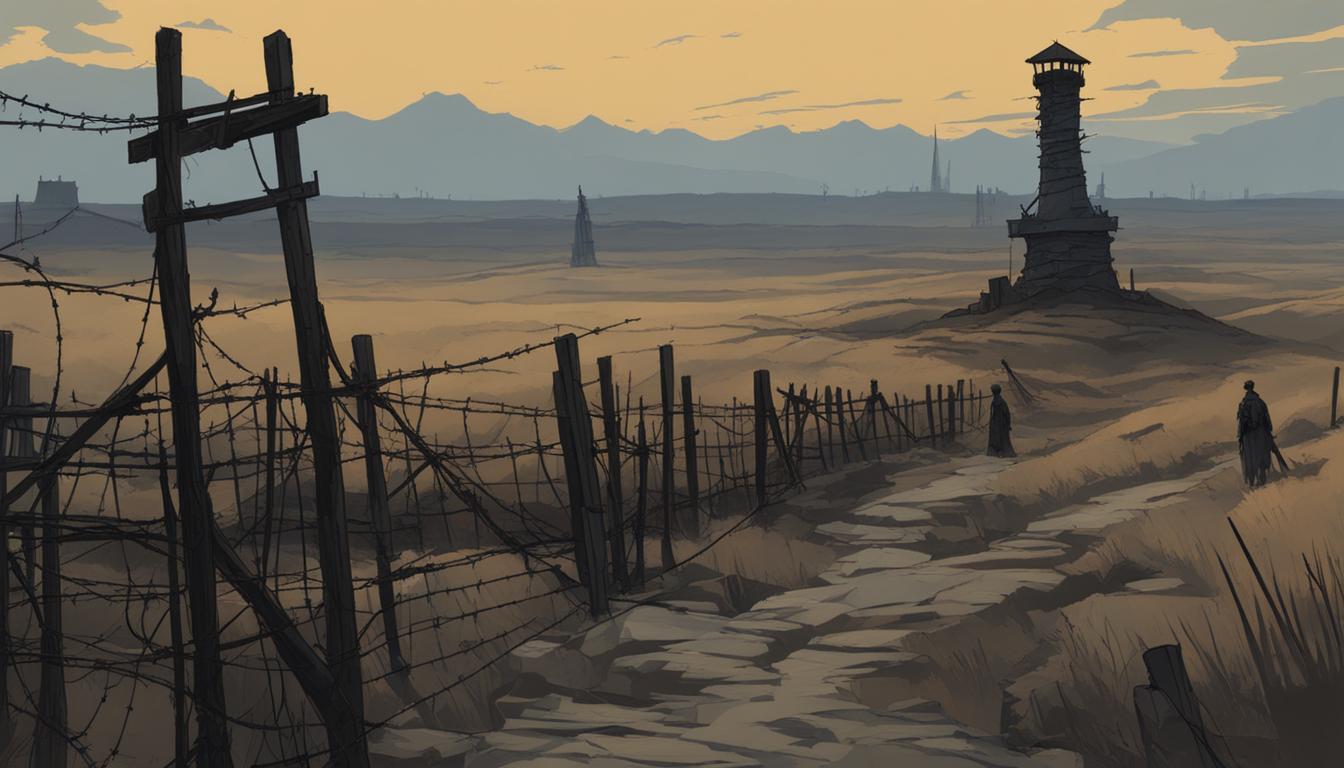Welcome to our book summary of “Gulag: A History” by Anne Applebaum. In this groundbreaking work, Applebaum provides a comprehensive account of the Soviet Gulag system, offering readers a deep understanding of the history and realities of Soviet labor camps. Published in 2003, this Pulitzer Prize-winning book is a must-read for anyone interested in the Soviet Union and its impact on the world.
Key Takeaways
- Applebaum’s “Gulag: A History” is a definitive account of the Soviet Gulag system.
- The book explores the origins, operations, and impact of the Gulag system from its establishment to its closure.
- Applebaum draws from extensive research, including Soviet-era archives and survivor testimonies.
- The Gulag system served as a tool for Stalin’s industrialization and economic plans, utilizing forced labor.
- “Gulag: A History” offers insights into the diverse population within the camps and the treatment of children.
About the Author
Anne Applebaum, the author of “Gulag: A History,” is a renowned historian specializing in the history of communist and post-communist Europe. With her extensive knowledge and expertise, she has established herself as a prominent figure in the field.
Applebaum’s profound understanding of the Soviet Union and its history stems from her personal experiences and thorough research. Her family has roots in what is now Belarus, providing her with a unique perspective on the subject matter.
“Gulag: A History” marked Applebaum’s first major literary achievement, garnering critical acclaim and recognition. In 2004, the book was honored with the Pulitzer Prize for General Non-Fiction, solidifying Applebaum’s position as a distinguished author and historian.
Overview of “Gulag: A History”
“Gulag: A History” provides a comprehensive overview of the Soviet Gulag system, shedding light on its origins, operation, and impact on the Soviet Union. The book meticulously traces the history of labor camps from the time of Vladimir Lenin’s reign to their eventual closure in the 1980s, offering a deep exploration of this dark chapter in history.
The author, Anne Applebaum, extensively draws from Soviet-era archives, personal memoirs, and testimonies of camp survivors to present a vivid and detailed account of the Gulag system. Through her research, she exposes the construction and management of the labor camps, the grueling conditions endured by prisoners, and the wide-ranging consequences on the Soviet Union’s society and economy.
The book’s exploration of the labor camps provides valuable insights into the immense scale of the Gulag system, which housed millions of prisoners over several decades. Applebaum examines the different categories of inmates, including political dissidents, criminals, and religious individuals, shedding light on the varied experiences within the labor camps.
By delving into the history of the Gulag, “Gulag: A History” offers a critical examination of the Soviet Union’s repressive regime and the violations of human rights that occurred within its labor camps. It serves as an essential resource for anyone wishing to deepen their understanding of this dark period in history and the lasting impact it had on the Soviet Union and its people.
For a visual representation of the Gulag system, refer to the following image:
Introduction to the Gulag
The Gulag, also known as the Main Camp Administration, played a pivotal role in the Soviet Union’s history. The acronym “Gulag” represents the vast network of labor camps and prisons that enforced Stalin’s industrialization and economic plans through forced labor. The introduction of “Gulag: A History” sheds light on the dehumanization and suffering that took place within the Gulag system, drawing comparisons to the atrocities committed in Nazi concentration camps.
The Gulag system emerged as a tool for Stalin’s regime to not only punish political dissidents, but also to drive rapid industrial growth. Through the forced labor of prisoners, the Soviet Union aimed to transform its economy and compete with capitalist nations. The Main Camp Administration was responsible for overseeing the various camps and ensuring the smooth operation of the system.
“The Gulag, acronym for Glavnoe Upravlenie Lagerei, or Main Camp Administration, designated the entire Soviet imprisonment system.”
By exploring the origins and nature of the Gulag system, “Gulag: A History” exposes the extent to which the Soviet Union prioritized economic agendas over human rights. The book’s introduction sets the stage for a deeper understanding of the dark realities experienced by millions of individuals subjected to forced labor and imprisonment.
Part I: The Origins of the Gulag, 1917-1939
This section delves into the early origins of the Gulag system under the Bolsheviks after the Russian Revolution. The Bolsheviks, led by Vladimir Lenin, aimed to establish a socialist society by dismantling the existing social and political structures. As part of their revolutionary vision, they created a vast system of labor camps known as the Gulag. One of the most significant early camps was the Solovetsky camp, situated on the Solovetsky Islands in the White Sea.
The Solovetsky camp holds a prominent place in the history of the Soviet labor camp system. It was established in 1923 and became a model for subsequent camps. The camp housed a mix of prisoners, including political dissidents, criminals, and intellectuals deemed a threat to the Soviet state. The camp administrators, staffed by the secret police and guarded by armed forces, employed various methods of control and punishment to maintain order.
The early Gulag camps lacked the structured organization that would later develop. Inefficiency was rampant as the Soviet government struggled to harness the potential labor force of its prisoners effectively. The hardships faced by the early camp inmates were compounded by the harsh conditions and inadequate resources.
The construction of the White Sea Canal marked a turning point in the development of the Gulag system. Ordered by Stalin in the late 1920s, the canal aimed to connect the White Sea to the Baltic Sea, facilitating transportation and bolstering industrial development. The project’s realization relied heavily on the forced labor of Gulag prisoners, showcasing the increasing complexity and scale of the camp system.
Part II: Life and Work in the Camps
Part II of “Gulag: A History” delves deep into the day-to-day experiences of prisoners within the Soviet Gulag camps. This section uncovers the various justifications for arrests, shedding light on the arbitrary nature of the Soviet government’s actions. Many individuals found themselves in the wrong place at the wrong time or faced accusations of having foreign ties, all leading to their arrest and subsequent imprisonment.
The book explores the interrogation process and the psychological torments endured by the prisoners. Interrogations often involved brutal torture tactics, aiming to extract information or confessions from the detainees. This systematic abuse left lasting scars on the minds and bodies of those subjected to it, reinforcing the harsh realities of life in the camps.
Within the Soviet Union, different prisons scattered across the vast territory housed countless prisoners. Each prison had its own set of strict rules and regulations, aimed at maintaining control and instilling fear in the inmates. The prisoners had to adapt and develop survival strategies to endure the harsh conditions and constant surveillance.
Surviving against all odds
The strategies for survival adopted by prisoners within the Gulag camps were as diverse as the individuals themselves. Some prisoners formed close-knit groups to provide support and protection, while others sought solace in religious beliefs or maintained a sense of hope for the future. The determination to survive and the resilience exhibited by these individuals under unfathomable circumstances are testaments to the strength of the human spirit.
“The conditions in the Gulag were unimaginable. The brutal interrogations and the constant fear kept us on edge every day. But we found solace in each other’s company, supporting one another as best we could. It was the only way to survive in that unbearable environment.” – Ivan Petrov, Gulag survivor
The image above depicts the grim reality of the torture tactics employed by the Soviet government within the Gulag camps. It serves as a haunting reminder of the atrocities endured by the prisoners during their time in captivity.
Camp Population and Types of Prisoners
This section provides insight into the diverse population within the Gulag system. It looks at the different categories of prisoners, including political prisoners, exiles, kulaks, and religious individuals. The narrative explores the conditions and challenges faced by these various groups, shedding light on the different experiences within the camps.
The Gulag system encompassed a wide range of individuals, each with their own unique circumstances and stories. Political prisoners, who posed a perceived threat to the Soviet government, made up a significant portion of the camp population.
Exiles were another category of prisoners in the Gulag. These individuals were often forcibly relocated from their homes to remote regions of the Soviet Union, where they were subjected to labor and harsh living conditions.
Kulaks, a term used to describe prosperous peasants, were also targeted by the Soviet regime. They were seen as a threat to collectivization efforts and were often stripped of their land and possessions before being sent to the Gulag.
Political Prisoners
“The Gulag system served as a tool for suppressing dissent and maintaining the Soviet government’s power. Political prisoners, including intellectuals, activists, and members of opposition groups, were subjected to imprisonment and forced labor as a means of silencing dissenting voices.” – Anne Applebaum
Exiles
“Exiles faced a double punishment – not only were they removed from their homes and separated from their families, but they were also forced to endure grueling labor and inhumane conditions in remote regions of the Soviet Union.” – Anne Applebaum
Kulaks and Religious Individuals
“Kulaks, as well as individuals practicing religious beliefs outside of state-sanctioned norms, were targeted by the Soviet regime. They suffered the loss of their property and were subjected to the same harsh conditions as other prisoners in the camps.” – Anne Applebaum
The diversity within the Gulag population highlights the systemic nature of the Soviet repression. Despite their different backgrounds, all prisoners faced immense challenges and hardships in their quest for survival.

The Atrocities and Treatment of Children
One particularly harrowing aspect of the Gulag system was the treatment of children. The Soviet Union’s criminal class included not only adults but also innocent children who faced unimaginable hardships within the Gulag camps. These young souls were subjected to a cruel and unjust fate, enduring unimaginable suffering as a result of their parents’ perceived crimes against the state.
The children of enemies of the people were stigmatized and ostracized in the camps, marginalized by both the authorities and their fellow inmates. They were seen as guilty by association, carrying the burden of their parents’ alleged crimes.
The struggle for survival became even more challenging for these children. They faced extreme deprivation, lacking access to basic necessities such as food, healthcare, and education. The harsh conditions, coupled with physical and emotional abuse, left a lasting impact on their lives.
Furthermore, the Gulag system had an enduring effect on these children, even long after their release from the camps. They were often classified as part of the Soviet Union’s criminal class, carrying the stigma and limitations associated with such branding. This had detrimental consequences for their personal and professional lives, as they were continually subject to discrimination and prejudice.
The treatment of children within the Gulag system serves as a painful reminder of the human rights violations and atrocities committed by the Soviet Union. It is a tragic chapter in history that should never be forgotten, as it highlights the profound impact of political ideologies on the lives of innocent individuals.
International Perception and Economic Impact
This section explores the international condemnation faced by the Gulag system and its economic implications. Reports of forced labor in the Soviet Union were widely disseminated in international press outlets, sparking outrage and condemnation from the global community.
The use of slave labor in the Soviet Union posed a significant economic threat. The exploitation of millions of individuals in the Gulag camps enabled the production of goods at low or no cost, providing an unfair advantage in international trade. This economic advantage was seen as detrimental to fair competition and labor rights.
This international backlash against the Gulag system eventually led to actions aimed at curbing the importation of goods produced through forced labor. One notable example is the Tariff Act implemented in the United States. The Tariff Act restricted the importation of products made using forced labor, directly targeting goods produced within the Gulag system. This act served as a response to the economic threat posed by the exploitation of prisoner labor and aimed to protect ethical trade practices.

“Forced labor is a grave violation of human rights and undermines fair global trade standards. The international community has rightfully condemned the Gulag system, recognizing the economic threat it poses.”
After Stalin’s Death
The Gulag system underwent significant changes following the death of Joseph Stalin. Despite his absence, the camps continued to operate as prisons for various individuals, including democratic activists and criminals, well into the 1970s and early 1980s.
One notable figure who experienced the Gulag system during this period was the poet Joseph Brodsky. Brodsky, renowned for his literary talents, was arrested on charges of “parasitism” under the Soviet regime. His imprisonment and subsequent exile were emblematic of the continued control and repression exercised by the Soviet authorities in the post-Stalin era.
The impact of these changes and the imprisonment of figures like Brodsky shed light on the enduring nature of the Gulag system and the immense challenges faced by those caught in its clutches.
The Legacy of Joseph Brodsky
“The prison camps were the Soviet regime’s way of erasing individuality and dissent. My time in the Gulag reinforced my commitment to artistic expression and the promotion of freedom.” – Joseph Brodsky
Joseph Brodsky’s experience in the Gulag contributed to his profound understanding of the power of language and the importance of individual expression. Following his release and subsequent emigration to the West, Brodsky became an influential figure in the literary world, winning the Nobel Prize in Literature in 1987.
- Changes in the Gulag system after Stalin’s death
- Continued imprisonment of democratic activists and criminals
- The case of Joseph Brodsky and charges of “parasitism”
- The impact of the Gulag on Joseph Brodsky’s literary legacy
The Ongoing Significance of Joseph Brodsky
Joseph Brodsky’s writings and personal experiences continue to shed light on the enduring legacy of the Gulag system and the importance of preserving human rights and individual expression. As his powerful words resonate with readers around the world, they serve as a reminder of the atrocities committed under Soviet rule and the unwavering spirit of those who dared to defy it.
The Scale of the Gulag and Human Dignity
This section explores the vast scale of the Gulag system and the profound impact it had on human dignity. Within the confines of the Gulags, millions of individuals experienced unimaginable suffering, enduring various forms of abuse and deplorable conditions. Their stories serve as a stark reminder of the human rights violations that occurred within these camps.
The Gulag system was characterized by its magnitude, with an extensive network of labor camps spread across the Soviet Union. It is estimated that at its peak, the Gulag held millions of prisoners, who were subjected to forced labor, malnutrition, overcrowding, and brutal treatment. These individuals were stripped of their basic rights and dignity, forced to exist in a state of perpetual fear and suffering.
Within the vast scale of the Gulag, individual experiences varied greatly. Some prisoners managed to survive through acts of resilience and solidarity, while others succumbed to the harsh conditions or fell victim to the arbitrary violence inflicted by camp authorities. The human toll of the Gulag cannot be understated, as it scarred the lives of countless individuals and left a lasting legacy of trauma.
As we examine the scale of the Gulag system, it is crucial to confront the reality of the human rights violations that transpired within its confines. The stories of the victims highlight the need for justice and accountability, as well as a commitment to safeguarding human dignity in all circumstances. The revelations brought forth by “Gulag: A History” shed light on a dark chapter in history and serve as a testament to the resilience of the human spirit in the face of unimaginable adversity.

For the prisoners of the Gulag, the vastness of the system compounded their sense of isolation and despair. The scale of the Gulags cannot be ignored or forgotten, as it represents a grave violation of human rights and a painful reminder of the depths humanity is capable of sinking.
Reflections on the Gulag’s Legacy
The book “Gulag: A History” provokes contemplation on the enduring legacy of the Gulag system and its position within the Western imagination. One intriguing question emerges: Why does the Gulag not hold the same prominence in public consciousness as the Holocaust? Various theories attempt to shed light on this phenomenon.
- Lack of Awareness: One theory suggests that the Western imagination is less acquainted with the Gulag due to a lack of awareness or historical education on the subject. Unlike the Holocaust, which has been extensively covered in classrooms and popular culture, the Gulag remains relatively unexplored.
- Scale and Documentation: Another theory proposes that the vast scale of the Gulag might contribute to its diminished recognition. The extensive documentation and testimonies surrounding the Holocaust have helped cultivate a comprehensive understanding of its horrors, while the sheer numbers and scope of the Gulag system make it more challenging to grasp.
- Historical Framing: The comparison between the Holocaust and the Gulag also raises questions about the historical framing of these events. The Holocaust is often depicted as a systematic genocide, representing the embodiment of evil, while the Gulag is seen primarily as a tool of political oppression and forced labor. The historical narrative surrounding the Holocaust may have contributed to its more prominent place in collective memory.
Nevertheless, it is crucial to reflect on the significance of the Gulag and its relevance to the Cold War era. The Gulag system was a defining feature of Soviet society, reflecting the oppressive nature of the regime and its impact on millions of lives. By understanding the Gulag’s legacy, we gain valuable insights into the complexities of power, authoritarianism, and human resilience in the face of adversity.
Relevance of “Gulag: A History”
This section highlights the historical importance of “Gulag: A History” in providing a comprehensive account of the Gulag system. By delving into the lesser-known aspect of the Cold War, the book contributes to a deeper understanding of the Soviet Union and its history.
The significance of “Gulag: A History” lies in its ability to shed light on the human rights violations and the suffering endured by millions of individuals. It offers valuable insights into the impact of the Gulag system and its relevance in shaping perceptions of the Soviet Union and its role in the world.
“Gulag: A History” serves as a poignant reminder of the historical importance of the Soviet Union’s Gulag system. It unravels a painful chapter in Cold War history and brings to the forefront the human cost of authoritarian regimes.”
The book’s exploration of the Gulag system provides a crucial perspective on the Cold War era and its repercussions. By exposing the atrocities committed within the camps, “Gulag: A History” challenges conventional narratives and invites readers to reflect on the profound influence of the Soviet Union during this period.
Conclusion
In conclusion, “Gulag: A History” by Anne Applebaum is a highly recommended book for those interested in gaining a deeper understanding of the Soviet Union and its history. This book provides a comprehensive and well-researched account of the Gulag system, revealing the human rights violations and immense suffering endured by millions of individuals during that historical era. By delving into the dark realities of the Gulag, Applebaum shines a light on this lesser-known aspect of the Soviet Union’s past.
Moreover, “Gulag: A History” goes beyond a mere examination of the Gulag system itself. It also offers valuable insights into the broader historical era and the factors that contributed to the Cold War. Through meticulous research and powerful storytelling, Applebaum elucidates the ideological, political, and socio-economic reasons behind the creation and maintenance of the Gulags, providing readers with a deeper understanding of the Soviet Union’s impact on the world stage.
From its compelling narrative to its thorough analysis, “Gulag: A History” stands as a must-read book for anyone interested in the complex history of the Soviet Union. It is a testament to the importance of acknowledging and learning from the past, especially when it comes to the dark chapters of human history. By grappling with the horrors of the Gulag system, readers can gain a greater appreciation of the importance of human rights and the need to safeguard against such atrocities in the future.
FAQ
What is "Gulag: A History" about?
“Gulag: A History” is a non-fiction book by Anne Applebaum that provides a comprehensive account of the Soviet Gulag system. It explores the history, construction, and impact of the labor camps in the Soviet Union.
Who is the author of "Gulag: A History"?
The author of “Gulag: A History” is Anne Applebaum, a renowned historian with expertise in the history of communist and post-communist Europe. She won the Pulitzer Prize for General Non-Fiction for this book in 2004.
What does "Gulag" stand for?
“Gulag” stands for Main Camp Administration and refers to the entire Soviet imprisonment system. It played a significant role in furthering Stalin’s industrialization and economic plans through forced labor.
What does "Gulag: A History" cover?
“Gulag: A History” covers the origins of the Gulag system under the Bolsheviks, the experiences of prisoners within the camps, the diverse population within the Gulag system, the treatment of children, the international perception and economic impact of the Gulag, the changes in the Gulag system after Stalin’s death, and the scale of the Gulag and its impact on human dignity.



